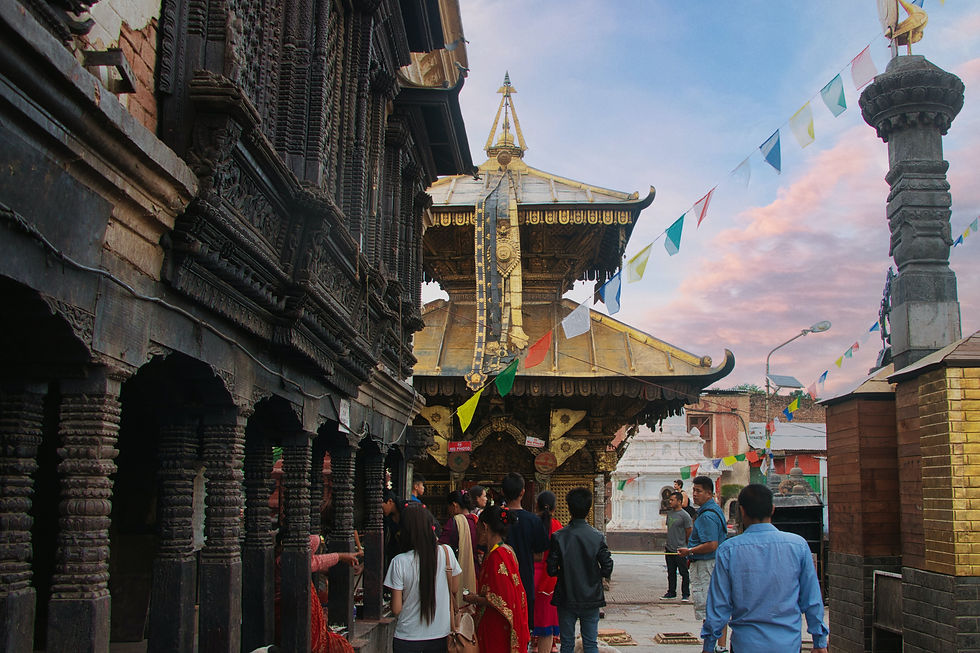Three Things to Observe in Swayambhunath Temple Premises
- Travel Maker South Asia

- Dec 24, 2022
- 3 min read
Updated: Jan 9, 2023
Swayambhunath
Swayambunath is an iconic Buddhist stupa that is easily recognizable; a golden spire that crowns a wooded hill and is situated to the west of Kathmandu. Popularly referred to as the "Monkey Temple" because of the hordes of monkeys that rove in and around the temple premises, it is one of the most ancient and enigmatic sites that is also considered one of the holiest of Buddhist shrines in the Kathmandu Valley.
Buddhists and Hindu pilgrims revere Swayambhu for its religious and spiritual significance. Inscriptions on the walls and temple premises provide significant evidence that the site has been a place of pilgrimage even long before Buddhism found its way into the Kathmandu valley dating back as far as the 5th century AD. The temple complex has an assortment of chaityas, temples, colorful painted images of deities, and various religious objects.
What Do The Eyes of Swayambhunath Say?
The eyes of the Swayambhunath Stupa are a prominent feature of the temple. They are often depicted in images and representations of the stupa. The eyes are painted on the four sides of the main stupa and represent the Buddha's all-seeing nature.

According to Buddhist belief, the Buddha is said to have the ability to see the world and all of its beings with perfect clarity and understanding. The eyes of Swayambhunath Stupa are meant to symbolize this ability.
The eyes are also said to represent the watchful nature of the Buddha, who is always present and aware of the suffering and joy of all beings. In this way, the eyes of Swayambhunath Stupa remind visitors of the Buddha's timeless and all-seeing nature and the importance of mindfulness and compassion in one's life.
One word that could describe the eye symbol of Swayambhunath Stupa is "enlightenment." The eye symbol represents the all-seeing nature of the Buddha, who is believed to have achieved a perfect understanding and enlightenment. It serves as a reminder to visitors of the importance of seeking enlightenment and developing mindfulness and compassion in one's own life.
Harati Temple
This temple is dedicated to the Goddess of epidemics, and devotees pray so that unwanted calamities do not befall them. The Harati Devi Temple is a fine example of the intermingling of Buddhism and Hinduism.

Palace of Peace
This is a rarely visited site situated atop a hill and is also locally known as 'Shantipur,' which means a 'Place of Peace.' It is believed that the 8th-century Tantric Master, Shankar Acharya, resides in the secret underground chamber. The master is said to have lived through centuries and has absolute control over the weather; even the King is supposed to visit him in times of drought or other unforeseen calamities.
Architecture
The base of the stupa is cubical and is crowned with a dome with the eyes of Buddha looking compassionately in all four directions. The pentagon-shaped Toran is present above each of the four sides with statues engraved. Behind and above the Torana are the thirteen tiers. Right above the tiers is a small space above which one will find Gaur.

The Myth Behind Swayambhunath
As per the Swayambhu Puran, the Kathmandu Valley at one time was filled with an enormous lake and in this valley grew the Mystical Lotus. This valley came to be known as 'Swayambhu,' meaning 'Self-Created' or 'Self-Existence.' The Bodhisattva Manjushree is believed to have a vision of this mystical and magical Lotus that prompted Manjushree to make a pilgrimage to worship it. However, the site was practically inaccessible to mortal pilgrims, and Majushree decided to cut a gorge through the mountains surrounding the valley. Once the water was drained, it created the Kathmandu Valley, and the Lotus transformed into a hill, and the flower eventually became Swayambhunath Stupa.
In Conclusion
In conclusion, visiting Swayambhunath Stupa is a truly unique and memorable experience. This ancient temple is a sacred site for Buddhists and Hindus alike. It is considered one of the most important religious sites in Nepal. Located on a hilltop overlooking the city of Kathmandu, the stupa is a beautiful and peaceful place to spend some time. Visitors can climb to the top of the hill, walk around the base, and visit the many shrines and temples around the stupa. In addition, the surrounding gardens and parkland offer a peaceful escape from the hustle and bustle of the city. Overall, Swayambhunath Stupa is a must-visit destination for anyone interested in religion, culture, or the beauty of Nepal.
Thank you for considering visiting Swayambhunath Stupa on your trip to Kathmandu. This beautiful and sacred temple is a must-see destination for anyone interested in Buddhism, Hinduism, or the rich cultural history of Nepal. We hope you will book a trip with us to experience the beauty and peace of this remarkable place for yourself. Contact us today to start planning your trip, and we look forward to welcoming you to Swayambhunath Stupa soon.






















Comments